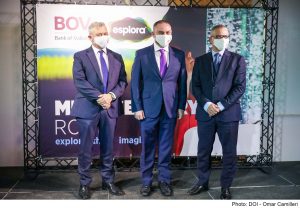
Minister for Research, Innovation and the Co-ordination of Post Covid-19 Strategy Owen Bonnici inaugurated a multisensory room project at the Esplora Interactive Science Centre together with the Malta Council for Science and Technology, Jeffrey Pullicino Orlando and Bank of Valletta Marketing Executive Charles Azzopardi.
Minister Bonnici explained that; “A multisensory room is described as being a therapeutic environment created for the express purpose of delivering high levels of stimuli to patients with dementia – a private room displays optical illusions with combined lighting effects, aromas, colours, textures and sounds to stimulate a person’s olfactory, auditory and gustatory systems. Sensory spaces have been shown to decrease negative behaviours and improve student engagement.”
Multi-Sensory Environments are created with two objectives in mind; to boost intellectual activity and to promote relaxation. They are envisaged to be a dedicated space in which sensory stimulation can be controlled, presented in isolation or combination, packaged for active or passive interaction, and matched to fit the perceived motivation, interests, leisure, relaxation, therapeutic and/or educational needs of the user.
“Esplora, with the help of Bank of Valletta, will be turning a 4.5m by 2.6m enclosure to a Multi-Sensory Room,” said Minister Bonnici. “Such a room would contain an array; lighting effects, such as projectors with wheels that disburse light patterns throughout the room, bubble lamps, spotlights, star panels, fibre optics, UV lights, mirror balls and even Christmas lights. These lighting effects are best seen if the room has a total blackout capability. The latter is very doable within the aforementioned space since this room has no windows. Sensory activities such as blowing bubbles, finger painting, and using play dough. Tactile experiences such as touching various, changing textures that are included in an interactive tactile wall panel. Cause and effect items such as the use of switches to allow the individual to control items within his or her environment, and toys that provide visual effects, vibrate, make noise, or have a tactile feel. Soft items on the floor such as mats, pillows, or beanbags. Sound effects such as children’s music, nature sounds, or animal sounds. Selected rhythmical music with a variety of tone, pitch, rhythm, and spacing can be used to soothe children, and motion stimulation, among others.”
In his speech, MCST Executive Chairman Jeffrey Pullicino Orlando said; “Esplora offers an inclusive and accessible environment for people with different abilities. This new project is the continuation of a series of related initiatives already being taken at Esplora.” He emphasised the importance of enabling people with different abilities to make the most out of their visit at Esplora. Dr Pullicino Orlando thanked BOV for their support on the project.
Some population groups that benefit greatly from the use of a sensory room including people with Alzheimer’s, Asperger’s Syndrome, ADHD, Cerebral Palsy, Dementia, Down Syndrome, Dyslexia, and Epilepsy. However, even those who do not fall into any abilities’ category can still benefit from the use of a sensory room, to process thoughts and emotions.
Such a relaxing and explorative experience is provided under the guidance of an enabler, which will train Esplora staff.
The room would be able to hold four people at one go, through pre-bookings. A community service will be offered by Esplora at no additional cost on top of the normal entry fees. Esplora will be also offering Autism-Friendly Hours and ADHD-Friendly Hours.










